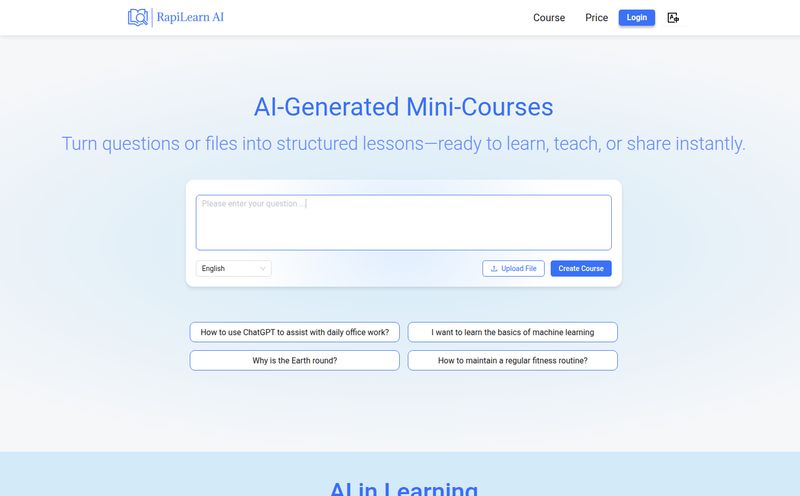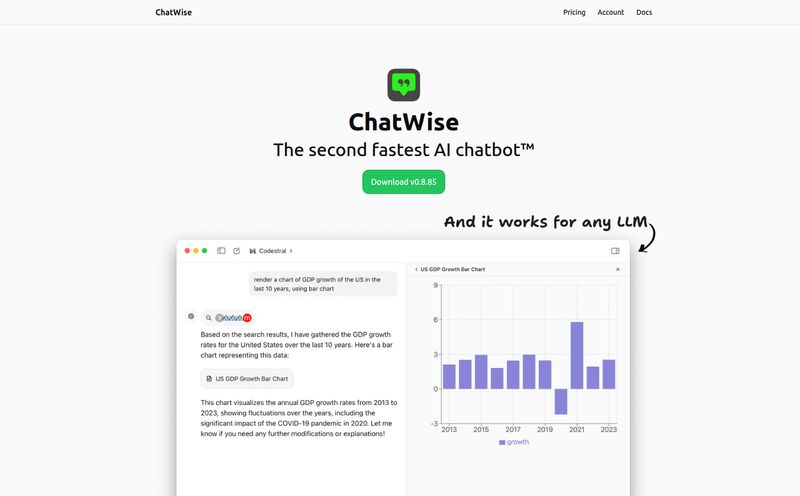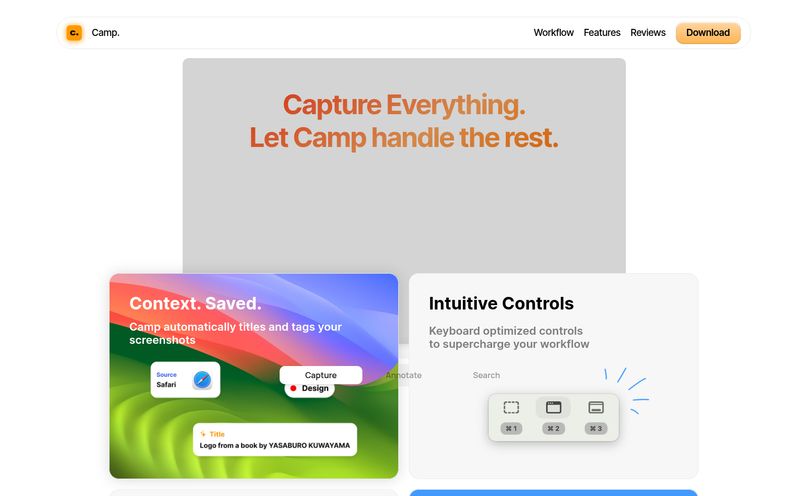We've all been there. You've got a scanned PDF—a chapter from a textbook, an old company report, a legal document from the stone age—and you need to pull the text out of it. You run it through a free online OCR tool, hold your breath, and open the result. It's a disaster. The formatting is a Picasso painting, half the words are gibberish, and what should have been a five-minute task has just become a two-hour manual cleanup job. The rage is real.
For years, I’ve been on a personal quest for the Holy Grail of OCR (Optical Character Recognition). Something that doesn't just try but actually succeeds. Most tools feel like they’re guessing, like a blurry-eyed intern transcribing notes after three hours of sleep. So when I stumbled upon a tool called PDFtoPDF.ai, my professional skepticism was cranked to eleven. But my curiosity? That was at a solid twelve.
So What Exactly is This PDFtoPDF.ai Thing?
In simple terms, PDFtoPDF.ai is an online tool that converts scanned PDFs into text-searchable, editable documents. But that’s like saying a Ferrari is just “a car.” The secret sauce here, according to their own materials, is the use of advanced OCR powered by deep learning. It’s not just looking for shapes that look like an 'A' or a 'B'. It's built to perform a deeper content analysis, to understand context and structure.
Think of it less like a simple transcriber and more like a digital archeologist. It’s designed to carefully excavate the text and, crucially, preserve the original layout. Titles, paragraphs, highlights, all the stuff that gives a document its meaning—it aims to keep it all intact. A bold claim, for sure.
The All-Too-Familiar Agony of Bad OCR
Before we go further, let's have a moment of silence for all the documents brutalized by subpar OCR software. I once had to convert a 200-page scanned research manual. The output from the “leading” free tool was… creative. Tables were turned into single, unending lines of text. Chapter headings were randomly inserted mid-paragraph. It would have been faster to retype the entire thing by hand. That experience left a scar.
This is the problem PDFtoPDF.ai is trying to solve. It’s not just about getting the words right; it's about respecting the document’s original intent and structure. Because without structure, information is just noise.
How PDFtoPDF.ai Might Just Change the Game
From what I've gathered, this tool hangs its hat on a few key promises. And if they hold up, they are pretty significant.
Its Obsession with Accuracy
The first thing that caught my eye was the emphasis on accurate text recognition. This is the baseline, the absolute minimum requirement, yet it's where so many tools fall flat. By using a deep learning model, PDFtoPDF.ai is supposedly trained on a massive amount of data, allowing it to recognize text with a much higher degree of precision than older, algorithm-based systems. It can better handle weird fonts, slight skews in the scan, and even some background noise. In theory, this means less time for you spent correcting typos like “he||o wor1d”.
Formatting That Actually Stays Put
This, for me, is the real potential game-changer. Anyone who works with academic papers, legal documents, or formatted reports knows that layout isn't just decoration. It's functional. PDFtoPDF.ai claims it can precisely restore original formats. We're talking about identifying and preserving:
- Titles and Subheadings: Kept in their proper place and hierarchy.
- Paragraphs and Line Breaks: No more giant, unreadable walls of text.
- Lists and Highlights: These visual cues are maintained, not discarded.
If it can do this reliably, it saves an incredible amount of reformatting time. It’s the difference between getting a ready-to-use document and a digital jigsaw puzzle.

Visit PDFtoPDF.ai
The “Deep Learning” Magic Behind the Curtain
Let's not get too technical, but “deep learning” is more than a buzzword here. Traditional OCR is like matching stencils. It sees a shape and says, “That looks like a ‘P’.” Deep learning is more like how a human reads. It understands that a large, bold line of text at the top of a page is probably a title. It sees an indented list with numbers and recognizes it as, well, a list. This contextual understanding is what allows for that superior formatting preservation. It's a smarter, more intuitive approach to document conversion.
Who Is This Tool Really For?
I can see a few groups of people getting really excited about this. Students and researchers, for one, who are constantly dealing with scanned book chapters and journal articles. Being able to quickly create a searchable, citable, and properly formatted digital version of a library book would be amazing. Legal and administrative professionals, too. They handle contracts and records where the original format is non-negotiable. And honestly, anyone in the content world who needs to digitize archives or old print materials without wanting to pull their hair out. It's a tool for anyone who values their time.
Are There Any Downsides?
No tool is perfect, right? Based on the available information, there are a couple of things to keep in mind. First, the tool requires JavaScript to run. For 99.9% of us, this is a non-issue as it’s standard in all modern browsers, but for those in high-security environments where scripts are disabled, it’s a barrier.
The other thing is a slight lack of transparency. While the promises are big, there isn’t a ton of detailed information on specific capabilities. For instance, how does it handle extremely complex documents with multiple columns, embedded images, and handwritten notes? We have to infer its power from its main claims, which is a bit of a leap of faith. I'd love to see a more detailed feature breakdown or a public-facing performance benchmark against competitors. Maybe that's teh SEO nerd in me talking.
The Million-Dollar Question: What's the Price?
And here we come to the big mystery. As of this writing, the pricing for PDFtoPDF.ai isn't publicly listed. This isn't uncommon for new tools in the AI space, many of which start in a beta or free-tier phase to attract users before rolling out paid plans. We could see a few potential models:
- A freemium model with a limited number of free conversions per day/month.
- A subscription-based model (e.g., monthly/yearly) for heavy users.
- A pay-as-you-go model with credits for each page or document.
My guess? It'll probably land on a freemium or subscription plan, which is pretty standard. For now, you’ll have to visit their site to see what the current access situation is. Fingers crossed for a generous free tier!
Frequently Asked Questions About PDFtoPDF.ai
What makes PDFtoPDF.ai different from other OCR tools?
The main differentiator is its use of deep learning for content analysis. Instead of just recognizing characters, it aims to understand the document's layout and structure, which allows it to preserve formatting like titles, paragraphs, and highlights more accurately than many traditional OCR tools.
Do I need to install any software to use it?
No, PDFtoPDF.ai is a web-based tool. You can access and use it directly from your browser without needing to download or install any software. You'll just need an internet connection and a browser with JavaScript enabled.
Can it handle complex layouts like tables and columns?
While not explicitly detailed, the tool's core promise of preserving original formatting suggests it has capabilities to handle more complex layouts. Its deep learning approach is better suited for interpreting structures like tables and columns compared to basic OCR, but the exact performance on very intricate documents would require testing.
Is PDFtoPDF.ai free?
Currently, there is no public pricing information. It might be in a free beta period or operating on a freemium model. The best way to find out is to visit their website directly.
What kind of documents work best with this tool?
It's designed for scanned documents where you want to extract text while keeping the structure. This includes scanned books, academic papers, business reports, historical archives, and legal documents. Clear, high-quality scans will always yield the best results.
Is my data secure when I upload a document?
Most reputable online tools have a privacy policy outlining how they handle user data. It's always best practice to check the site’s privacy policy or terms of service before uploading sensitive or confidential documents. I would assume they have standard security protocols, but it's always good to verify.
My Final Verdict
So, is PDFtoPDF.ai the messiah of document conversion I've been searching for? The jury's still out until I can throw some of my own nightmare PDFs at it. But I have to say, I'm optimistic. The approach is right. Focusing on accuracy and formatting is the only way to build an OCR tool that people will actually love to use.
It’s a specialized tool built to do one thing exceptionally well, and in a world cluttered with half-baked multi-tools, that’s incredibly refreshing. If it delivers on even 80% of its promises, it will be a massive win for anyone tired of the digital copy-paste struggle. It's definitely one to watch.
Reference and Sources
For more information on the technologies discussed, you can explore the following resources:
- The official tool website: While I cannot link directly, a search for "PDFtoPDF.ai" will lead you there.
- Optical Character Recognition - Wikipedia: For a general background on OCR technology.
- What is Deep Learning? - IBM: An excellent primer on the core AI concept powering modern tools like this.



